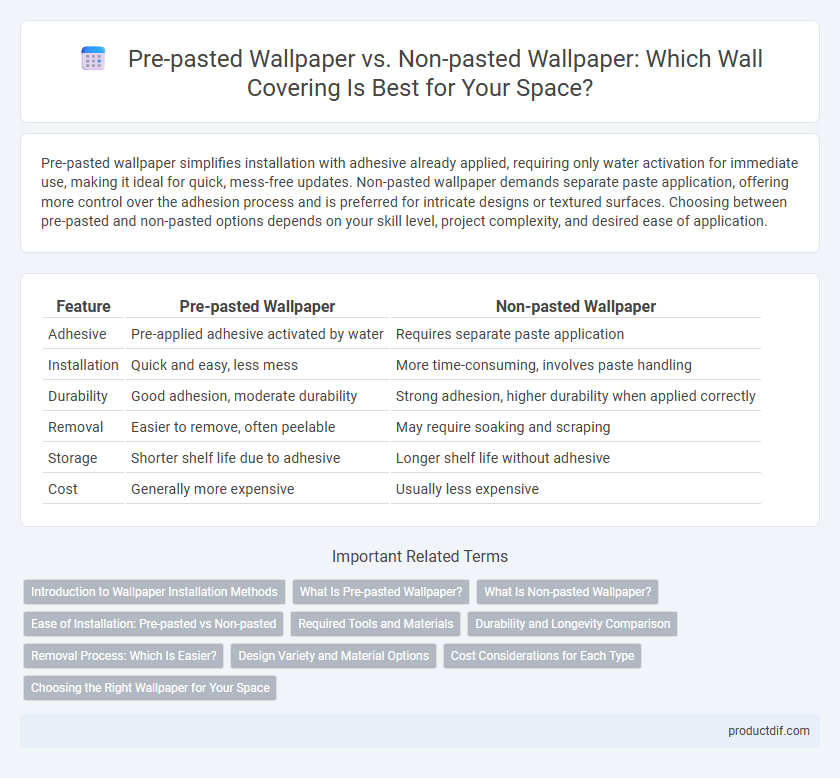Pre-pasted wallpaper simplifies installation with adhesive already applied, requiring only water activation for immediate use, making it ideal for quick, mess-free updates. Non-pasted wallpaper demands separate paste application, offering more control over the adhesion process and is preferred for intricate designs or textured surfaces. Choosing between pre-pasted and non-pasted options depends on your skill level, project complexity, and desired ease of application.
Table of Comparison
| Feature | Pre-pasted Wallpaper | Non-pasted Wallpaper |
|---|---|---|
| Adhesive | Pre-applied adhesive activated by water | Requires separate paste application |
| Installation | Quick and easy, less mess | More time-consuming, involves paste handling |
| Durability | Good adhesion, moderate durability | Strong adhesion, higher durability when applied correctly |
| Removal | Easier to remove, often peelable | May require soaking and scraping |
| Storage | Shorter shelf life due to adhesive | Longer shelf life without adhesive |
| Cost | Generally more expensive | Usually less expensive |
Introduction to Wallpaper Installation Methods
Pre-pasted wallpaper features an adhesive backing activated by water, enabling faster and cleaner installation without the need for separate glue application. Non-pasted wallpaper requires manual application of paste before hanging, offering more control over adhesion and repositioning during installation. Understanding these key differences helps in selecting the appropriate wallpaper type based on ease of use, time investment, and surface conditions.
What Is Pre-pasted Wallpaper?
Pre-pasted wallpaper features an adhesive backing activated by water, allowing for easier and faster installation without the need for separate glue. This type of wallpaper is ideal for DIY projects as it reduces mess and simplifies alignment. Non-pasted wallpaper requires manual application of paste before hanging, making pre-pasted wallpaper a convenient alternative for hassle-free wall covering.
What Is Non-pasted Wallpaper?
Non-pasted wallpaper requires separate application of adhesive directly to the wall before hanging, offering greater control over glue distribution and reducing the risk of paper damage during installation. This type of wallpaper is often preferred for complex patterns or textured surfaces, as it allows precise alignment without premature sticking. Non-pasted wallpaper typically demands more preparation time and skill but provides a customizable approach ideal for professional or detailed wallpaper projects.
Ease of Installation: Pre-pasted vs Non-pasted
Pre-pasted wallpaper offers significant ease of installation by featuring a ready-to-activate adhesive on the back, eliminating the need for separate glue application and reducing mess and preparation time. Non-pasted wallpaper requires manual glue application, which can be time-consuming and demands careful handling to avoid uneven adhesion or bubbling. The convenience of pre-pasted wallpaper makes it ideal for DIY projects and quick room transformations, while non-pasted wallpaper provides more control for professional installers seeking precise application.
Required Tools and Materials
Pre-pasted wallpaper requires only water to activate the adhesive, eliminating the need for separate glue, brushes, or pasting tables, making it convenient and less messy for DIY projects. Non-pasted wallpaper demands additional tools such as wallpaper paste, a brush or roller for application, a smoothing tool, and a pasting table to ensure proper adhesion and alignment. Choosing between pre-pasted and non-pasted wallpaper significantly impacts preparation time and the inventory of tools and materials needed for a successful wall covering installation.
Durability and Longevity Comparison
Pre-pasted wallpaper features an adhesive layer activated by water, offering ease of application and moderate durability, particularly suitable for low-traffic areas. Non-pasted wallpaper requires separate adhesive application, providing stronger adhesion and enhanced longevity, making it ideal for high-traffic environments or rooms with high humidity. Durability-wise, non-pasted options typically outperform pre-pasted versions due to their robust adhesive bond and resistance to peeling over time.
Removal Process: Which Is Easier?
Pre-pasted wallpaper features an adhesive backing that activates with water, allowing for easier removal by simply moistening the paper and peeling it off, making it ideal for quick renovations. Non-pasted wallpaper requires applying wallpaper paste during installation and often demands a more intensive removal process, including soaking and scraping to eliminate residual glue. Choosing pre-pasted wallpaper minimizes wall damage and cleanup time, streamlining the removal process for homeowners.
Design Variety and Material Options
Pre-pasted wallpaper offers limited design variety and material options due to its adhesive backing, typically favoring paper and vinyl blends for easy application. Non-pasted wallpaper provides a broader selection of designs and materials, including textured fabrics, grasscloth, and high-end vinyls, allowing for greater customization and durability. This versatility makes non-pasted wallpaper ideal for intricate patterns and unique finishes that enhance interior aesthetics.
Cost Considerations for Each Type
Pre-pasted wallpaper generally incurs a higher upfront cost due to the adhesive layer and convenience features, while non-pasted wallpaper is often less expensive but requires separate adhesive purchase and application. The total expense for non-pasted wallpaper rises with the cost of glue and the time investment in preparation. Budget-conscious consumers might prefer non-pasted options to control adhesive quality and quantity, but pre-pasted wallpaper saves on labor and cleanup costs, impacting overall project budget.
Choosing the Right Wallpaper for Your Space
Pre-pasted wallpaper simplifies installation with an adhesive backing activated by water, making it ideal for DIY projects and quick application. Non-pasted wallpaper requires separate adhesive application, offering greater control and customization for intricate patterns and textured surfaces. Selecting the right wallpaper depends on your skill level, wall condition, and the desired finish to ensure a durable and visually appealing result.
Pre-pasted Wallpaper vs Non-pasted Wallpaper Infographic

 productdif.com
productdif.com